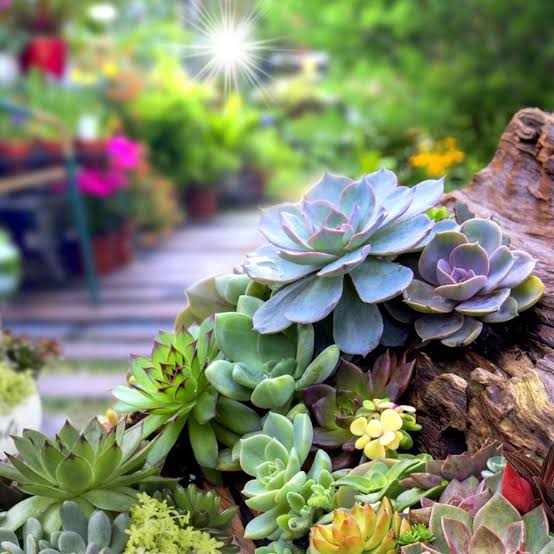If you’re looking for a fresh, modern way to elevate your outdoor space, you can transform your garden with succulent garden design! Succulents are stylish, resilient, and visually striking—perfect for gardens of any size, climate, or style. Whether you live in a sunny California backyard, a compact London terrace, or a Canadian home hoping for something low-care yet beautiful, succulents offer endless design possibilities.This guide will walk you through everything you need to know about succulent garden design, from choosing plants and planning layouts to soil, care, containers, and practical tips for long-lasting success. With a bit of creativity, you can transform your garden into a stunning, sculptural showcase that’s both water-wise and easy to maintain.Why Choose Succulent Garden Design?Succulent gardens are popular for good reason. They combine beauty and practicality, making them a great addition to landscapes in the US, UK, and Canada.1. Low Water & Low MaintenanceSucculents store water in their leaves, allowing them to thrive with minimal watering. This is ideal for:Busy homeownersDrought-prone areasVacation homesPeople new to gardening2. Unique Textures and ColorsSucculents offer incredible variety, including:Deep greensReds, purples, and bluesVariegated patternsRosette, trailing, and architectural shapesThey add interest and contrast to your garden like no other plants can.3. Versatile for Any SpaceYou can design with succulents in:Ground bedsRaised plantersContainersRock gardensVertical wallsIndoor/outdoor bordersNo matter your garden’s size, you can transform your garden with succulent garden design!H2: Getting Started with Succulent Garden DesignBefore planting your succulents, it’s important to prepare your space, select the right varieties, and understand their growing needs.H3: Choosing the Best Succulent VarietiesDifferent climates require different succulent types. Here’s what works best in each region:United StatesWarm, dry states (California, Arizona, Nevada):AgavesAloesAeoniumsEcheveriasSedum varietiesCooler states (Northeast, Pacific Northwest):Hardy sedumSempervivum (hens-and-chicks)JovibarbaUnited KingdomWith the UK’s mild, damp climate, choose:SempervivumHardy sedumsDelospermaSmaller agave varieties (in containers)CanadaCold climates require extra toughness:Hardy sedumsSempervivumCold-tolerant JovibarbaIndoor/outdoor container succulents during warm monthsThese choices will help you transform your garden with succulent garden design no matter where you live.H3: Planning Your Succulent Garden LayoutA thoughtful layout is key to making your garden look professional and cohesive.1. Choose a Focal PointSucculents with bold structure make excellent focal plants:AgaveAloeLarge AeoniumZebra haworthia in containers2. Think in TexturesCombine:Rosette shapes with spiky formsTrailing varieties with upright plantsSmooth leaves with rough edgesThis creates depth and visual movement.3. Use Height VariationMix tall, medium, and low succulents to create dimension.4. Pick a Color PaletteOptions include:Soft pastel tones (pinks, lavenders, light greens)Bold contrasts (reds, oranges, deep greens)Monochrome greensYour color choice helps transform your garden with succulent garden design into a cohesive masterpiece.H2: Designing Different Types of Succulent GardensThere are many ways to incorporate succulents into your landscape. Choose the style that fits your home best.H3: 1. Rock GardensRock gardens are one of the most natural ways to display succulents. Stones provide excellent drainage and mimic desert landscapes. Combine boulders, gravel, and hardy succulents like sedums and sempervivum for a rugged, sculptural look.H3: 2. Container Succulent GardensPerfect for small patios, balconies, and renters.Benefits:Easy to rearrangeSuitable for cold climatesGreat for experimenting with colors and texturesChoose shallow, wide containers for rosette-style succulents.H3: 3. Vertical Succulent GardensWall planters, frames, and hanging displays allow you to use succulents as living art. Ideal for modern homes or compact areas. Use trailing succulents like string of pearls, donkey tail, or hanging sedum.H3: 4. Desert-Inspired LandscapesCreate a desert oasis using gravel pathways, raised beds, cacti, aloe, and agave. Works especially well in dry US climates but can be adapted with containers in cooler countries.H3: 5. Mixed Bed Succulent GardensBlend succulents with non-succulent plants such as lavender, ornamental grasses, thyme, or dwarf shrubs. This softens the look and adds seasonal variation.H2: Soil, Watering, and Sun RequirementsProper care is essential if you want to transform your garden with succulent garden design and keep it thriving long-term.H3: Soil NeedsSucculents require well-draining soil.Best soil types:Cactus mixDIY mix (50% potting soil + 50% sand/perlite/gravel)Avoid heavy, clay-rich soils.H3: Watering TipsLess is more.Water deeply but infrequentlyLet soil dry completely between wateringsAvoid water sitting on rosettesContainers need more frequent watering than ground beds.H3: SunlightSucculents love sun, but intensity varies by type.Most need 4–6 hours of sunlight dailyIn hot US states, provide afternoon shadeIn Canada/UK, place succulents in the brightest spot availableIndoor succulents thrive near south- or west-facing windows.H2: Practical Tips to Transform Your Garden with Succulent Garden Design!These expert-level tips will help elevate your garden from simple to stunning.H3: 1. Use Gravel or Pebbles as Top DressingTop dressing helps:Improve drainageGive a polished, professional lookPrevent weedsKeep rosettes cleanH3: 2. Group Succulents with Similar NeedsKeep plants with the same light and water requirements together for easier care.H3: 3. Filter Sun for Delicate VarietiesUse shade cloth or position under taller plants to protect sun-sensitive succulents.H3: 4. Protect Succulents from FrostIn Canada and parts of the UK:Bring containers indoorsAdd mulch for insulationUse frost cloths in winterH3: 5. Propagate for Free PlantsOne of the best perks of succulents is how easily they multiply.Ways to propagate:Leaf cuttingsStem cuttingsOffsets (“pups”)Root divisionThis lets you grow your garden at zero cost.H3: 6. Mix Heights with Decorative StonesAdd boulders, driftwood, or stepping stones for structure and artistry.H3: 7. Choose Drought-Tolerant CompanionsLavender, sage, rosemary, and ornamental grasses blend beautifully with succulents.H3: 8. Play with PatternsCreate designs using repeating shapes or color blocks for modern, eye-catching layouts.Conclusion: Transform Your Garden with Succulent Garden Design Today!Whether you’re a beginner or a seasoned gardener, succulents offer an exciting opportunity to build a garden that’s beautiful, artistic, and low-maintenance. With their bold shapes, vibrant colors, and endless variety, these plants make it easy to transform your garden with succulent garden design!From rock gardens and vertical walls to container arrangements and desert landscapes, succulents fit every style and climate. By choosing the right varieties, providing proper care, and following the design tips in this guide, you can create a garden that thrives with minimal effort and brings beauty year-round.

